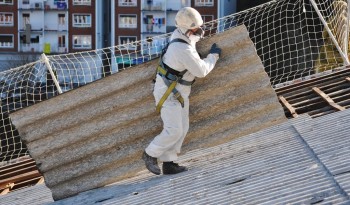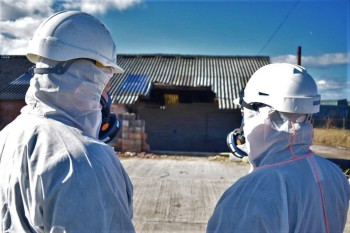Managing Risks of Asbestos in Soils: Expert Strategies for Safe Soil Management
ASBESTOS IS A NATURALLY OCCURRING MINERAL FOUND WITHIN SOME ROCKS, SEDIMENTS AND SOILS. THE MAJORITY OF NATURALLY OCCURRING ASBESTOS IS AT DEPTH AND IS THEREFORE VERY UNLIKELY TO BE ENCOUNTERED IN URBAN SETTINGS. HOWEVER, DEBRIS FROM MANUFACTURED ASBESTOS PRODUCTS NEAR SURFACE SOILS ACROSS DEVELOPED AREAS IS ENCOUNTERED QUITE REGULARLY AND CAN POSE SIGNIFICANT RISKS.
Given its excellent heat resistant properties (non-flammable to over 2000°C), tensile strength, electrical and chemical resistant properties, asbestos was historically used in the manufacture of thousands of products in the construction industry.
Understanding Asbestos in Soils: Key Risks and Prevention Measures
Asbestos containing products were widely used in Australia, predominantly between the 1940’s and 1980’s with the most common building products used during this period including:
Corrugated asbestos cement sheets (used for roofing and fencing)
Asbestos cement sheets (used for internal and external walls of ‘fibro’ houses, eaves, lining of buildings and walls within wet areas)
Vinyl floor tiles, backing to vinyl floor sheeting.
Whilst these were the most commonly used, numerous other asbestos items were utilised during this period within buildings, including:
Asbestos insulation in some areas
Electrical switchboard box linings
Backing panels
Cable insulation
Fire doors
Roof shingle tiles
Asbestos cement water & sewer pipes
Telecommunication pits
Hot water system & pipe insulation
Rope seals, gaskets
Spray on insulation to beams
Formwork associated with building footings.
COMMON SOURCES OF (NON-NATURAL) ASBESTOS IN SOILS
Asbestos is often found as one of the contaminants in soil and comes in a range of forms, sizes and degrees of deterioration in the form of:
Asbestos-Containing Material (ACM)
Fibrous Asbestos (FA)
Asbestos Fines (AF).
Sites can be contaminated by former waste disposal, industry and other activities. The contamination is frequently discovered during changes to land use, for example industrial to residential, and can have considerable implications for local councils, landowners, prospective purchasers and other stakeholders.
HISTORICAL PRACTICES
Dealing with asbestos waste is now highly regulated and generally with a high degree of care. Historically this was not always the case, which has resulted in legacy issues.
Historical (and unfortunately sometimes current) demolition practices also tended to leave significant asbestos debris on and under the surface of a site.
GENERAL FILL
Asbestos is sometimes found in older general fill material as a result of historical practices, (where asbestos in fill would not have been considered as a potential problem) and can cause widespread contamination of a site. Asbestos fragments can however also make their way into more modern material used as fill (often a result of soil being sourced from a site where historical demolition practices or dumping have led to asbestos being present in the material).
Illegal Dumping
While a better understanding on the risks of asbestos has contributed to better practices in the building industry; asbestos waste is still commonly found buried on a site or dumped on the surface. Unfortunately, disposing of asbestos correctly involves significant time, care and expense. This is a contributing factor in the incorrect and illegal disposal of asbestos products on sites.
EXTREME EVENTS
Extreme events can also be responsible for the location of asbestos in soils. For example, asbestos in soils can be found across large areas of Darwin, as extreme events such as World War II bombings (1942) and Cyclone Tracy (1974) both generated a large amount of building debris that contained asbestos. The documentation around the management of this debris is scant, and areas of dumped/buried waste are still being uncovered. According to precedent, this would also be the case for other natural disasters over time, particularly fires, floods, and extreme weather events across the country.
Recycled Products
There are instances where widespread asbestos debris has been found in recycled crushed concrete product and mulch. This occurs when some asbestos debris finds its way into the recycling process, which can happen a number of ways, such as asbestos formwork not being identified on concrete footings, or the inclusion of asbestos waste in concrete disposal (either accidently, or as a form of illegal dumping). This Asbestos Contaminated Material (ACM) can then potentially be on-sold to numerous parties for use as recycled products.
Other less common, but still significant, sources of asbestos in soil includes asbestos cement pipework that has been left on a site, irrigation areas where water at high pressure is being fed through this pipework, and roof runoff driplines from highly weathered corrugated roof sheets.
WHAT IS THE RISK?
Asbestos poses a risk to human health through the inhalation of fibres. The inhalation of asbestos fibres can cause disease of the lungs, including asbestosis, lung cancer and mesothelioma. As with any ACM, if the asbestos is left undisturbed, then it does not pose a risk.
In buildings, the main risk of exposure to asbestos fibres is generally through the disturbance of products through drilling, cutting, or removal.
In soil, risks are presented when:
Excavation works are carried out through buried asbestos in soil (e.g., digging a trench, excavating for a swimming pool or basement, site levelling for new construction)
Disturbance of a surface that has asbestos containing debris (e.g., lawn mowing or driving on ‘hard’ surfaces like gravel).
This disturbance can degrade the matrix of the debris containing asbestos (usually cement) to the point where dust generated from the surface of a site could potentially contain asbestos fibres
Where friable asbestos exists (defined as being able to be crushed by hand to release fibres), anything that causes even minor soil disturbance or dust generation can result in the mobilisation of asbestos fibres into the atmosphere.
ASSESSMENT, MANAGEMENT & REMEDIATION
The primary guidance documents detail the steps to be taken when addressing asbestos in soil issues, and include assessment/remediation methods, acceptable criteria for asbestos in soil, and recommended management measures.
When it comes to the assessment of asbestos in soil, it is important to consider:
What needs to be included in a Preliminary Site Investigation (Site walkover and historical review)
How to adequately assess for asbestos in soil in a Detailed Site Investigation (sampling grid densities, targeted sampling guidance, sampling collection methodologies, safety in sampling)
Who is undertaking the assessment and ensuring they have adequate training and competencies
Acceptable management and/or remediation methodologies
Validation and ongoing management requirements after any remediation works.
Aside from the purely technical assessment and remediation guidance available, there are a number of factors that should be considered when it comes to selecting appropriate management and remediation of asbestos in soil, for example:
Stakeholder sensitivity
Location of the problem
Characteristics of the asbestos (e.g., friable vs bonded asbestos)
Site limitations (whether remediation or management measures can actually be implemented)
Time constraints
Future management requirements
Soil type characteristics (dealing with asbestos in sandy soil is quite different to asbestos in clay).
Through increased industry awareness and regulatory guidance, asbestos in soil is an issue being identified with increased frequency. It is important to understand the available guidance on assessing, managing and remediating Asbestos in Soil Issues, along with any state/territory specific requirements. Given the complexities that can be involved, regulations require Asbestos in Soil assessments and the provision of advice around remediation and/or management to be carried out by experienced personnel.
How Ace Environmental can help
Ace Environmental has built a wealth of experience and expertise since its beginning as an asbestos consultanc. We assists in the development of a range of effective solutions to manage contaminated land and the investigation and remediation of a wide variety of contaminants in soils such as asbestos.











